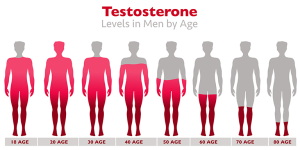Testosterone Replacement Therapy (TRT) has gained attention in recent years for its potential to significantly improve various aspects of health and well-being. As men age, testosterone levels naturally decline, which can lead to a range of physical and emotional issues, including fatigue, decreased libido, and mood swings.
TRT offers a way to restore testosterone levels to a more youthful state, potentially reversing some of these symptoms. This therapy not only targets hormonal balance but also aims to enhance overall quality of life by improving energy levels, muscle mass, bone density, and mental clarity. In this discussion,
We will explore the various ways TRT can transform health and the benefits it may bring to those who are experiencing the effects of low testosterone.

Low testosterone, or hypogonadism, affects millions of men worldwide. Symptoms often include fatigue, decreased libido, mood swings, and diminished muscle mass. Identifying low testosterone levels is crucial for determining whether TRT is appropriate.
Blood tests measuring total testosterone levels are the standard method of diagnosis.

TRT involves administering testosterone through various methods, including injections, patches, gels, or pellets. Each delivery system has its advantages and disadvantages, allowing patients to choose the option that best suits their lifestyle.
Patients with certain medical conditions, such as prostate cancer or severe heart issues, may be advised against hormone therapy. A healthcare professional can provide guidance on whether TRT is a suitable option based on individual health needs.
By considering possible lifestyle changes alongside therapy, individuals can experience even greater benefits from TRT. With proper management and support, men can regain their vitality and enjoy a healthier future.
TRT offers a way to restore testosterone levels to a more youthful state, potentially reversing some of these symptoms. This therapy not only targets hormonal balance but also aims to enhance overall quality of life by improving energy levels, muscle mass, bone density, and mental clarity. In this discussion,
We will explore the various ways TRT can transform health and the benefits it may bring to those who are experiencing the effects of low testosterone.
Understanding Low Testosterone:

Low testosterone, or hypogonadism, affects millions of men worldwide. Symptoms often include fatigue, decreased libido, mood swings, and diminished muscle mass. Identifying low testosterone levels is crucial for determining whether TRT is appropriate.
Blood tests measuring total testosterone levels are the standard method of diagnosis.
The Benefits of Testosterone Replacement Therapy:
1. Increased Energy Levels
One of the most notable benefits of TRT is the boost in energy levels. Many men report feeling revitalized and more energetic after starting therapy. This surge in energy can lead to increased productivity at work and improved performance in physical activities.2. Enhanced Mood and Mental Clarity
Low testosterone is often linked to mood disorders such as depression and anxiety. TRT may help alleviate these symptoms, promoting a more balanced emotional state. Additionally, many patients experience improved mental clarity and cognitive function, helping them stay focused and engaged.3. Improved Libido and Sexual Function
For men facing reduced libido and sexual dysfunction, TRT can be life-changing. Restoring testosterone levels often leads to enhanced sexual desire and improved erectile function. This transformation can strengthen relationships and boost self-esteem.4. Increased Muscle Mass and Strength
Testosterone plays a vital role in muscle development and maintenance. With TRT, many men experience significant gains in muscle mass and strength. This enhancement is particularly beneficial for those involved in regular physical training or looking to improve their overall fitness levels.5. Reduction in Body Fat
TRT can also aid in weight management by promoting fat loss while preserving lean muscle mass. As testosterone levels increase, metabolic function improves, making it easier to maintain a healthy weight. This change not only enhances physical appearance but also contributes to overall health.How TRT Works?

TRT involves administering testosterone through various methods, including injections, patches, gels, or pellets. Each delivery system has its advantages and disadvantages, allowing patients to choose the option that best suits their lifestyle.
1. Injection Therapy
Intramuscular injections are one of the most common forms of TRT. This method involves injecting testosterone directly into the muscle, allowing for rapid absorption into the bloodstream. Injections typically occur every one to three weeks, depending on the prescribed dosage.2. Transdermal Patches and Gels
Patches and gels offer a more convenient alternative to injections. These products allow testosterone to absorb through the skin, providing a steady release of the hormone throughout the day. Patients can apply these treatments daily, making them easy to incorporate into their routine.3. Pellet Therapy
Testosterone pellets are small implants inserted under the skin. They release testosterone slowly over several months, providing a long-lasting solution for those who prefer not to deal with regular injections or daily applications.Potential Risks and Side Effects of TRT
While TRT offers numerous benefits, it's essential to consider potential risks and side effects. Common side effects may include:- Acne or oily skin
- Sleep apnea
- Increased red blood cell count
- Possible prostate enlargement or increased risk of prostate cancer
Who Should Consider TRT?
Men experiencing symptoms of low testosterone should consult their healthcare provider to discuss potential treatment options. It's essential to undergo thorough testing to confirm low testosterone levels before starting TRT.Patients with certain medical conditions, such as prostate cancer or severe heart issues, may be advised against hormone therapy. A healthcare professional can provide guidance on whether TRT is a suitable option based on individual health needs.
Lifestyle Changes That Complement TRT
While TRT can lead to significant health improvements, combining therapy with healthy lifestyle changes can maximize results:1. Regular Exercise
Engaging in regular physical activity is crucial for overall health. Strength training and cardiovascular exercises not only enhance the benefits of TRT but also help maintain healthy body weight and improve mood.2. Balanced Nutrition
A well-rounded diet rich in whole foods provides essential nutrients that support hormonal balance. Incorporating lean proteins, healthy fats, and plenty of fruits and vegetables can enhance the effectiveness of TRT.3. Quality Sleep
Adequate sleep is vital for hormone production and overall well-being. Prioritizing sleep hygiene can lead to better recovery, improved mood, and enhanced energy levels.4. Stress Management
Chronic stress can negatively impact testosterone levels. Practicing stress-reducing techniques such as meditation, yoga, or deep-breathing exercises can promote hormonal balance and overall health.Monitoring Progress on TRT
Regular follow-ups with a healthcare provider are essential for monitoring progress on TRT. Blood tests will assess testosterone levels, hematocrit (red blood cell count), and other vital markers to ensure the therapy is effective and safe.Conclusion
In summary, Testosterone Replacement Therapy can profoundly transform health for men suffering from low testosterone levels. By addressing symptoms such as fatigue, low libido, and decreased muscle mass, TRT can significantly enhance quality of life. However, it is vital to approach treatment under the guidance of a qualified healthcare professional to ensure safety and effectiveness.By considering possible lifestyle changes alongside therapy, individuals can experience even greater benefits from TRT. With proper management and support, men can regain their vitality and enjoy a healthier future.

